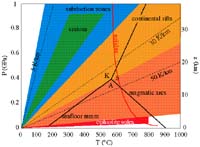
There was a brief introduction to plate tectonics and metamorphism at the beginning of this class. Now let's consider this issue in more detail.
stable cratons (green): cratons are stable and relatively cold, with 'normal' thermal gradients of ~20 K/km. In detail, this simplification is incorrect. Continental rocks usually begin life somewhat hotter than this as a result of crustal stacking and radiogenic heat generation, but then cool over time.
Magmatic arcs (red-orange) are sites where heat is advected to shallow levels, producing low P/T metamorphism. The heat is chiefly provided by silicate melts derived from melting of the upper mantle. Contact metamorphism is common in such settings. Good examples of this include the Sierra Nevada and Klamath Mountains. At this locality in Norway, a dike swarm at the base of a pluton led to contact metamorphism:
that is discernible in the decussate texture of this metavolcanic wall rock:
Regional contact metamorphism is caused by pluton intrusion and cooling over a large area. Shown here is Cretaceous plutonism and cooling from the Dabie Shan of China:
During extension at mid-ocean ridges (red-orange), convection carries heat to very shallow levels, where 7-km thick oceanic crust forms; hydrothermal circulation produces low P/T metamorphism, often called seafloor metamorphism:
Many good examples of seafloor metamorphism are known from ophiolites in the Sierra Nevada and Klamaths.
The shallowest levels of ocean crust are only weakly metamorphosed to zeolite facies:
The hallmark of magmatic extension is sheeted dikes, which are usually partially altered to greenschist facies:
The underlying gabbros are heterogeneously altered, mostly around hydrothermal circulation zones:
Ophiolite soles (red) form in thrust zones beneath very hot oceanic lithosphere emplaced onto passive continental margins. In contrast to other low P/T metamorphism, inverted metamorphic gradients form because the emplacement rate is rapid compared to the rate at which the extreme heat is conducted away. The type example of this is the Samail ophiolite in Oman, shown here in a Landsat image:
The Samail Ophiolite is one of the world's largest, coherent sheets, with an areal extent of ~150 x 500 km:
It is well exposed, such that all possible questions can be answered:
"Tethyan-type" ophiolites are emplaced onto passive continental margins by subduction of the continental margin beneath an intraoceanic, immature arc:
Specifically, intraoceanic thrusting may begin along transform faults where young and old lithosphere are juxtaposed:
This process leads to the formation of a metamorphic sole with an inverted metamorphic gradient:
The metamorphic sole is well exposed as a 200-m thick well foliated and lineated section:
U/Pb zircon and 40Ar/39Ar dating shows that the intraoceanic thrusting took <2 Myr:
Leading to a cooling history that is very rapid (and very similar) in both the oceanic crust and the metamorphic sole:
The continental margin rocks record high pressures and the ophiolite sole shows high temperatures that are easily modeled as the result of emplacement of very young (<2 Myr old) lithosphere. The continental margin underwent deep burial and minor heating followed by cooling and decompression, whereas the metamorphic sole underwent substantial heating and minor compression and then cooling and decompression:
Rapid subduction advects cold material into the mantle, producing high P/T metamorphism (blue), sometimes called "Franciscan-type" or "Sambagawa-type" in reference to two classic examples in California and Japan. The "coldness" of the subduction zone depends on the age of the plate (older = colder) and the rate of subduction (faster = colder). Eclogites are the signature rocks of this process.
The signature rocks of high-pressure metamorphism and blueschists and eclogites.
Blueschist-facies rocks are often incompletely reacted to the high-pressure assemblage, leading to variable preservation of igneous textures and/or minerals, as exhibited by this outcrop from the Klamath Mountains:
Eclogites in many locations occur as blocks within a more felsic matrix:
The host gneiss is usually, after considerably more searching, also found to contain evidence of high-pressure metamorphism. Other localities, such as Oman, however, contain extensive intact tracts of high-pressure rocks:
The eclogite at Verpeneset, Norway, contains Na-pyroxene + garnet (which define an eclogite), plus rutile, kyanite, and zoisite:
This eclogite from Dabie Shan China contains abundant phengite, the Mg+Fe+Si-rich form of muscovite:
"Warm" subduction zones--a result of slow subduction and/or young subducted lithosphere and "cold" subduction zones-- a result of rapid subduction and/or old subducted lithosphere, have different thermal regimes, dehydration depths, mantle wedge temperatures and circulation, and styles of volcanism.
A model "warm" subduction zone is Nankai:
A model "cold" subduction zone is Tohoku:
Recall that the characteristic diffusion distance for a thermal pulse to move over a 1 Ma time frame is ~5 km. This is an average movement rate of 5 km/Ma. Thus, a steady state thermal regime cannot be disturbed by advection that is slower than this, because the thermal diffusion is able to "iron out" the effects of diffusion. If, however, the advection rate is faster, the thermal regime will be disturbed, and, in the case of subduction zones, will lead to an inverted thermal gradient. This ratio between the effects of conduction and advection is called the Peclet number.
The subducted crust and mantle contains a heterogeneous distribution of hydrous metamorphic minerals. These minerals break down during subduction, producing fluids that reach the mantle wedge and cause melting of the mantle peridotite (the introduction of H2O lower the solidus):